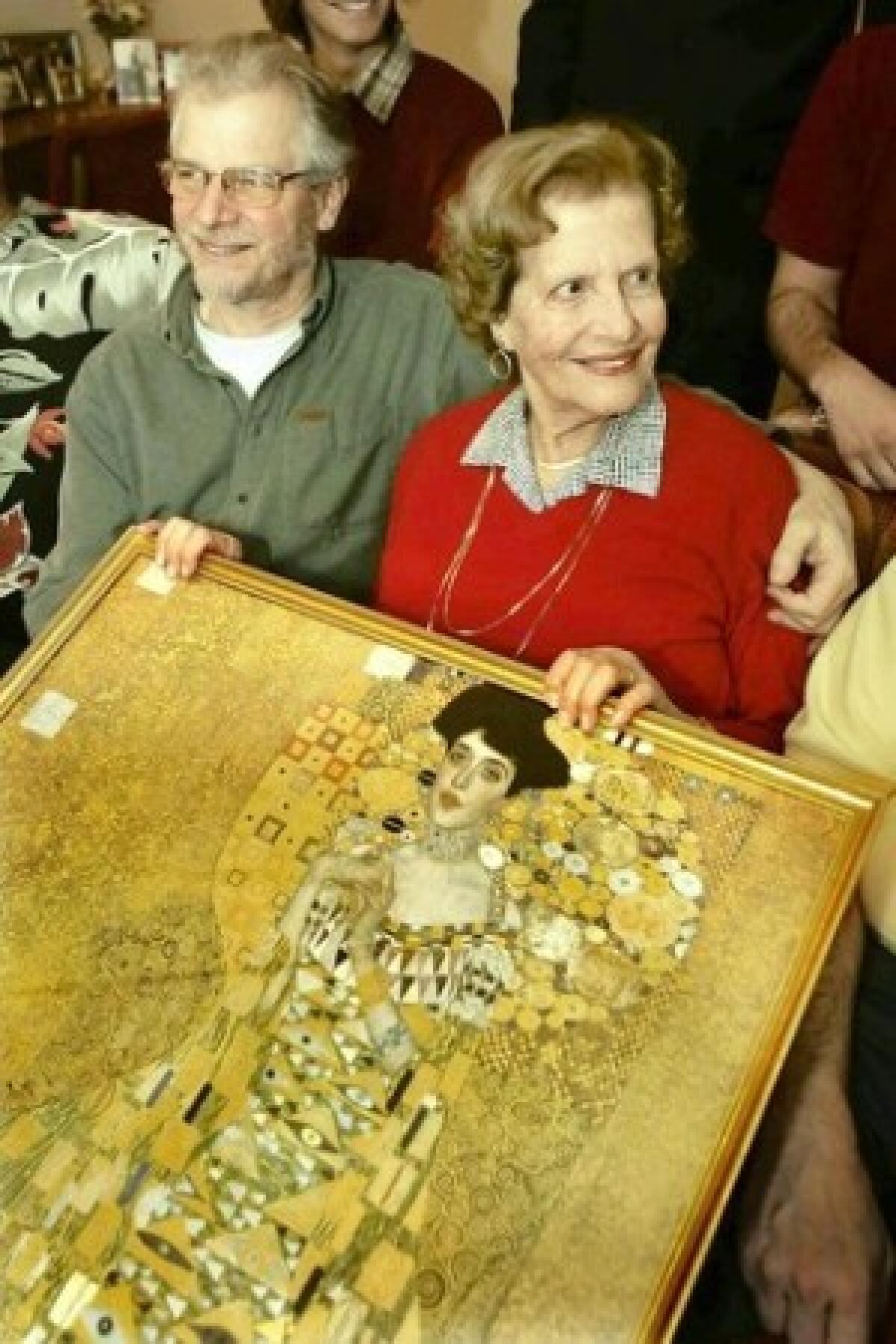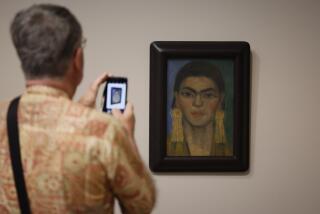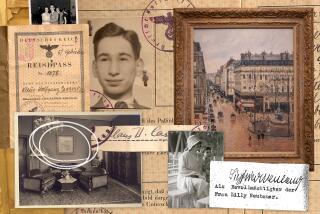Maria Altmann dies at 94; won fight for return of Klimt portrait seized by Nazis

- Share via
Maria Altmann, who escaped Nazi-occupied Vienna as a newlywed and returned to wage a triumphant fight to recover Gustav Klimt’s iconic gold portrait of her remarkable aunt, has died. She was 94.
Altmann died Monday at her Cheviot Hills home after a long illness, said family friend E. Randol Schoenberg.
Altmann was an 82-year-old grandmother living in Cheviot Hills in 1998 when she enlisted Schoenberg, an attorney who was the son of a friend, to investigate the Nazi theft of her Jewish family’s Klimt collection. The collection included Klimt’s famous “Portrait of Adele Bloch-Bauer,” hanging in the Austrian National Gallery.
The seemingly unwinnable battle took Altmann and Schoenberg to the U.S. Supreme Court — which ruled that the case could go forward. An Austrian mediation panel ultimately awarded Altmann and four other heirs the five Klimt paintings in January 2006.
“They delay, delay, delay, hoping I will die,” Altmann said in 2001. “But I will do them the pleasure of staying alive.”
Her family’s triumph sent shockwaves through the art restitution world, museums — and the art market. Cosmetics baron Ronald S. Lauder bought the gold portrait of Adele, calling it the “Austrian Mona Lisa,” for $135 million, a record at the time. It remains on permanent display at Lauder’s Neue Galerie in New York. The four other paintings brought $192.7 million at auction at Christie’s and disappeared into private collections after being shown at the Los Angeles County Museum of Art and the Neue Galerie.
“She never stopped believing that the paintings would come out,” Lauder said. “I thank her for her resilience.”
The seven-year legal battle was a raison d’etre for Altmann, a retired dress shop owner who was still selling clothes from her home when she began the case. She asked interviewers to excuse her when clients arrived, serving everyone Viennese coffee with dollops of whipped cream, addressing them as “my darling” and “my love.”
Born Maria Viktoria Bloch-Bauer in Vienna on Feb. 18, 1916, Altmann was the youngest of five children of Therese Bauer and Gustav Bloch. Her mother’s sister, Adele, married Gustav’s brother, Ferdinand, who had taken over his father’s sugar factory. After the Bauer sons died, the families united their surnames as Bloch-Bauer, in the style of Vienna aristocrats.
The Bloch-Bauers had their portraits painted by artists. Adele was a newlywed when Klimt began the gold-encrusted painting influenced by the Byzantine mosaics of Ravenna that became the “Portrait of Adele Bloch-Bauer.” Along with “The Kiss,” his erotically charged portrait of a passionately entwined couple, and “Judith,” in which he portrays the Old Testament heroine as a bare-breasted femme fatale, the “Portrait of Adele Bloch-Bauer” was a masterpiece of his gilded phase and a sublime embodiment of Vienna’s golden moment of artistic and intellectual vitality.
The portrait was a sensation when it was unveiled in 1907, and it made Adele an instant celebrity. Studded with Egyptian motifs and subtly erotic symbols, Adele’s face floated in the painting like a silent screen star. Klimt painted Adele with an expression of such vivid restlessness and longing that viewers would question the relationship between Adele and the artist, a notorious seducer.
In 1912, Klimt completed a second portrait, rendered in a highly colored style more reminiscent of Matisse. This work showed an older Adele, with teeth stained by cigarettes and an expression that had turned from longing to resignation. Her only child born alive had died after just a few days; most viewed her marriage as a union of mutual respect.
Klimt died in February 1918, as World War I sounded the death knell for the Austro-Hungarian Empire.
Altmann was just a child when her celebrated Aunt Adele presided over a lively Vienna salon. A self-declared socialist and atheist, she was a rare woman in a man’s world of ideas and arts.
Adele died suddenly in 1925 of meningitis at the age of 43. In her will, she had asked her husband to donate the paintings to the National Gallery upon his death.
But in March 1938, Adolf Hitler annexed Austria to Germany and cast a greedy eye on Vienna’s wealth.
Altmann had just returned from her Paris honeymoon with her husband, Fritz.
“They now say Austria was a victim of the Nazis,” Altmann said. “Believe me, there were no victims. The women were throwing flowers, the church bells were ringing. They welcomed them with open arms. They were jubilant.”
Among Vienna’s Jews, however, there was only terror. Synagogues were destroyed. Elderly Jews committed suicide. Family treasures were plundered, including Altmann’s diamond necklace.
In an attempt to gain control of the family’s bank accounts, the Gestapo sent Fritz Altmann to Dachau. He was freed when his brother, a textile manufacturer, promised to hand over his foreign accounts. Maria and Fritz escaped on foot to Holland.
Ferdinand fled to Switzerland, leaving the palatial estate he had shared with Adele and their formidable collections of art and porcelain. The Austrian National Gallery snapped up the gold portrait of Adele, which was delivered with a letter proclaiming “Heil, Hitler!”
From his exile, Ferdinand unsuccessfully tried to recoup the portraits of his wife and other paintings but died at a Zurich hotel in November 1945, seven months after Hitler’s suicide signaled the downfall of Nazi Germany.
More than 50 years later, in 1999, Altmann was a widow with four adult children and grandchildren when she learned details of the Nazi dispersal of her family’s art collection. Austrian investigative journalist Hubertus Czernin had obtained access to long-sealed state archives that had covered up the thefts from wealthy Jewish families, including the Bloch-Bauers and the Rothschilds. Czernin’s reports led the Austrian government to pass a new restitution law, opening the way for the return of looted art from the Nazi era.
Altmann seized the chance to stake her family’s claim. Armed with a copy of her aunt’s will that Czernin had uncovered, she and her young lawyer, Schoenberg, argued that Adele had not given the paintings away to the state-run gallery; she had only asked her husband, who owned them, to make the gift. In his will, he left them to Altmann and two of her older siblings, Luise and Robert.
Viennese authorities insisted Adele’s will was uncontestable. But correspondence between Austrian authorities in the postwar era showed they were aware they were on shaky legal ground when they held on to the paintings.
Schoenberg left his law firm to pursue the case, which most viewed as an uphill battle. Austria insisted the case be heard there, initially demanding a $1.8-million deposit against legal costs. Schoenberg won a 2001 victory in a Los Angeles federal court saying the dispute could proceed in U.S. courts.
Austria appealed to the U.S. Supreme Court, which ruled in June 2004 that the case could go forward. When Schoenberg suggested they accept Austria’s offer to resolve the case with a three-man arbitration panel instead, “I thought he was crazy,” Altmann said.
It was a great surprise when the Austrian panel ruled, in January 2006, that the five Klimt paintings should be returned.
LACMA officials prepared a room to display the paintings, hoping to acquire the golden portrait of Adele, and were disappointed by Lauder’s purchase.
By the time of the Christie’s auction in November 2006, Altmann’s health was fading. She donated to the arts, especially the opera, but otherwise her life changed little. She resisted family efforts to get her to redecorate the house she had shared for years with Fritz.
Altmann is survived by three sons, Charles of Cheviot Hills, Peter of Puget Sound, Wash., and James of Agoura Hills; a daughter, Margie Crain of Solana Beach; and numerous grandchildren and great-grandchildren.
O’Connor is a former Times staff writer.
More to Read
Start your day right
Sign up for Essential California for the L.A. Times biggest news, features and recommendations in your inbox six days a week.
You may occasionally receive promotional content from the Los Angeles Times.






